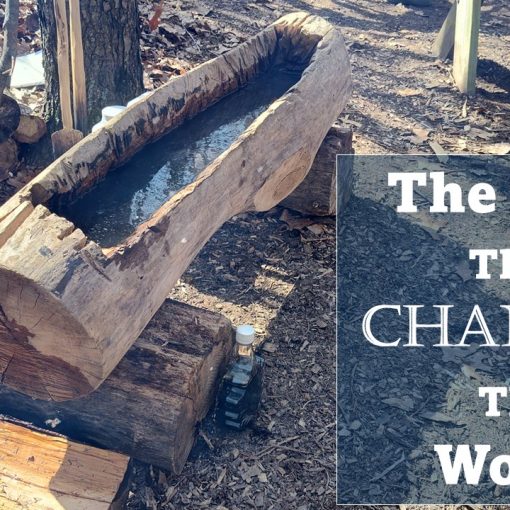Were you aware that “Labor Day” had started with a strike at the Pullman Train Car Factory south of Chicago? There had been thirty deaths and scores of workers who were injured by our National Guard. Join us for a deeper look into the beginning of our country’s holiday, Labor Day.
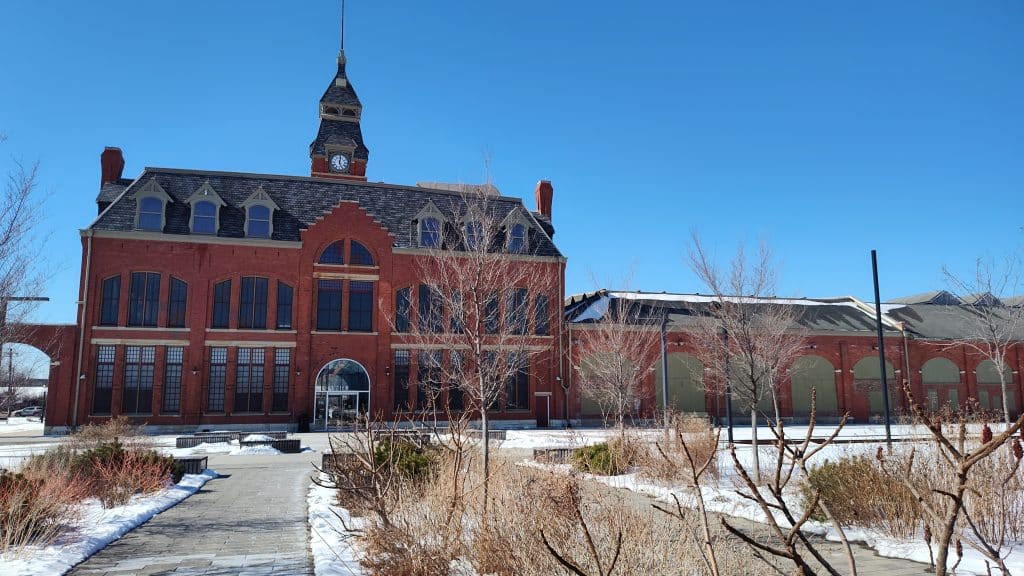
George Pullman, owner, had designed an entire town for his workers.
Chuck and I crunched over crusted April snow to the restored Pullman Factory, now a museum. These buildings are drenched in accounts of human struggle. The bricks hold stories of the ‘Pullman Utopia’ and how this social system fell apart. Standing on these grounds and witnessing the A. Philip Randolph Museum, brought me a clearer understanding of Labor Day and the events that led to our country’s holiday. Pullman Park deserves its distinction as one of our 63 National Parks.
When Did Pullman Train Cars Become Popular?
This story starts back in 1865 with Abraham Lincoln’s death.
The Pullman sleeping cars had gained notoriety when they had been part of the Abraham Lincoln’s funeral train. His body had been escorted home by train alongside dignitaries, who preferred comfort while traveling.
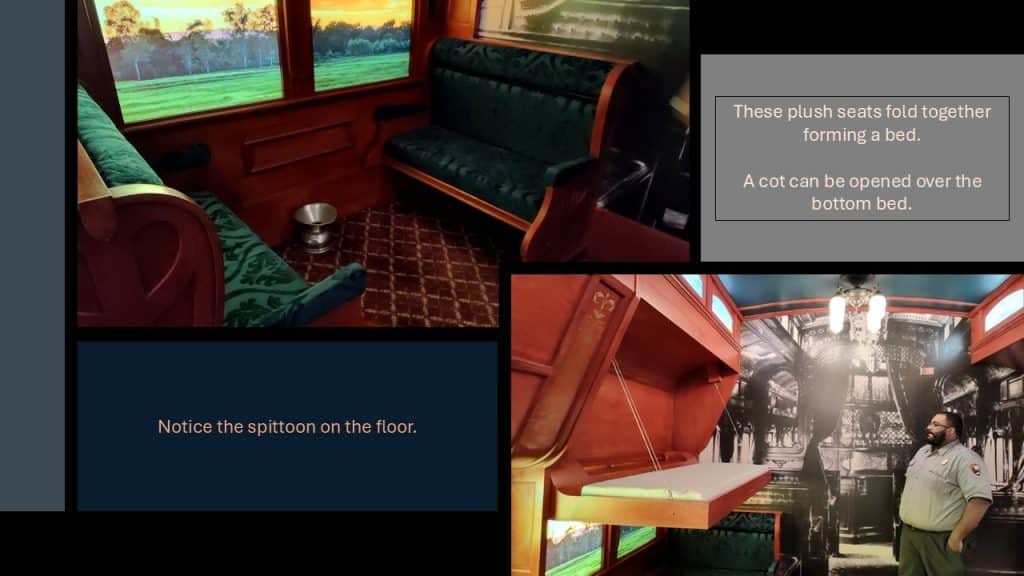
The route had started in Washington D.C. and headed north through eastern Pennsylvania. Then, it turned west moving through New York, across Ohio and Indiana to Chicago. Finally, the train advanced south to Lincoln’s home in Springfield, Illinois.
With this vast exposure, crossing several of the thirty-six states across our country, orders for Pullman sleeping cars came in droves. By 1879 the company had 464 cars for lease. African American porters, maids and cooks worked tirelessly to ensure travelers a luxurious journey.
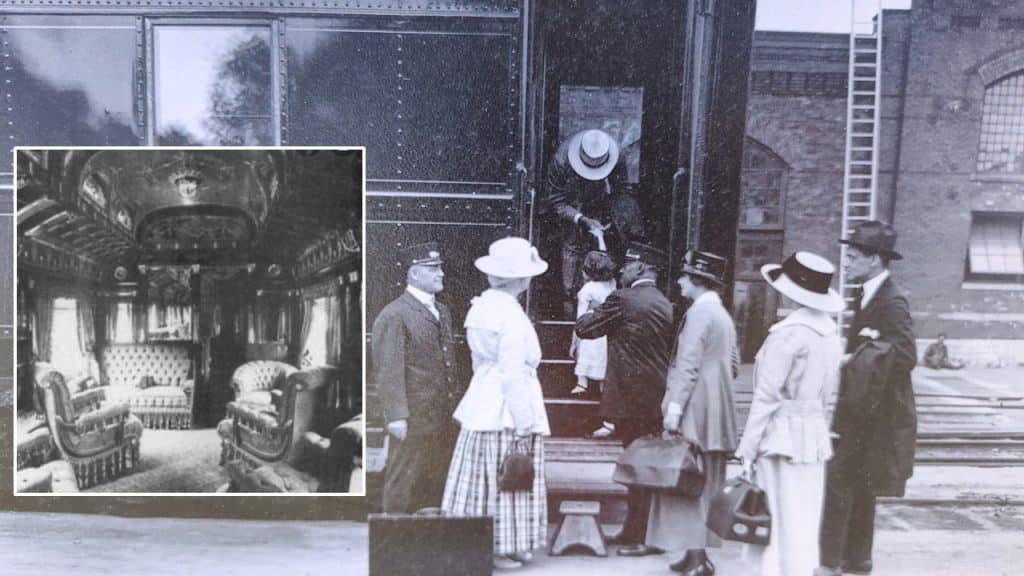
Visionary owner, George Pullman, realized how valuable his work force would be in producing his Pullman train cars. Providing for his workers had been a priority and would guarantee a successful business. With a prosperous company, Pullman would be able to pay his investors their expected profit installments.
Pullman Village – Capitalist Utopia
In 1880 George Pullman purchased 4,000 acres south of Chicago, along the shore of Lake Calumet. His company town provided everything his workers would need, a “Capitalist Utopia.” The European workers had decent housing which they could rent from the company. These homes had running water and gas lighting, which had been luxury at that time.

Photo Credit: (left) Pullman National Park
The Village of Pullman was thought of as “The Perfect Town.” (1896) Goods could be purchased from the company store. Residential maintenance and daily garbage services were included within the town of Pullman. A doctor had been employed to care for the community. Later another physician joined the ranks. The future appeared to be secure!

This Village of Pullman had been the first of its kind in our country. Providing for his workers, Pullman hoped to retain and entice loyalty to him and his company. He had even built a hotel and named it for his daughter, Florence. Several other ‘company towns’ had been modeled after this community.
Sue Bennett, assistant superintendent of the Pullman National Park, had been interviewed by Chicago Stories and said, “He (George Pullman) hoped that it would be capitalism helping labor equally, while labor helped capitalism.”
By the thirteenth year, 12,000 workers and their families were housed in the Village of Pullman. This well-kept neighborhood appeared ideal, however Pullman held the town in the palm of his hand. He controlled the rent, the food which could be purchased and even kept a tight account on the books in the library.
In addition, there had been notable segregation. African American porters, cooks and maids had lived closer to the rail lines. Their rentals had been subpar, yet the expectations for highly rated services remained top of the line.
Economic Downturn 1893
It was 1893, the thirteenth year of the ‘Pullman Utopia,’ when the economy took a downward turn. Pullman had made promises to his investors of earning 6% each year. In order to meet these promises, Pullman cut his worker’s wages by 25%, but he didn’t lower rent or grocery costs.
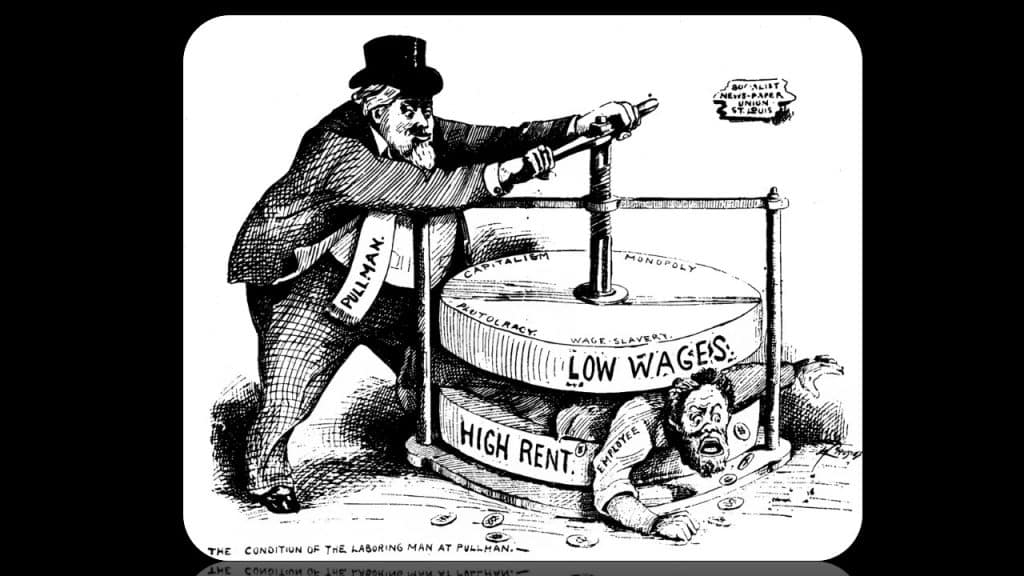
On May 5, 1894 several members, out of the forty-six, ‘Workers’ Grievance Committee’ had asked to meet with Pullman. If their demands for fair wages and adjusted rent weren’t met, they threatened to strike. Pullman refused and had those spokesmen fired.
“I have done as much for labor as any man living.” Pullman had been quoted in the newspaper. “I have always tried to treat my men squarely. But I am sick and disgusted by their treachery.” Pullman’s words were met with anger and resistance.
The Strike
It was May 11, 1894 when the Pullman workers walked off the job. Other factions, such as the American Railway Union (ARU), had joined the strike. Soon these acts had crippled commerce throughout the forty-two states.
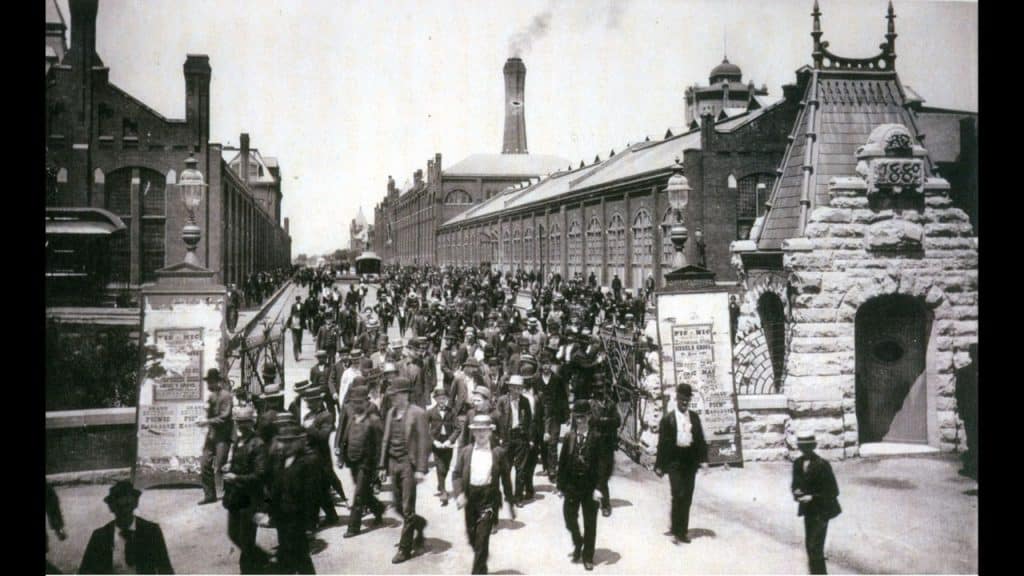
American Railway Union – ARU
Eugene Debs, leader of the American Railway Union, had stood beside the Pullman workers, boycotting Pullman railroad cars the following month.
“The strike began as a local dispute, but gradually expanded into a nationwide railway boycott.” reported the Periodical Press.
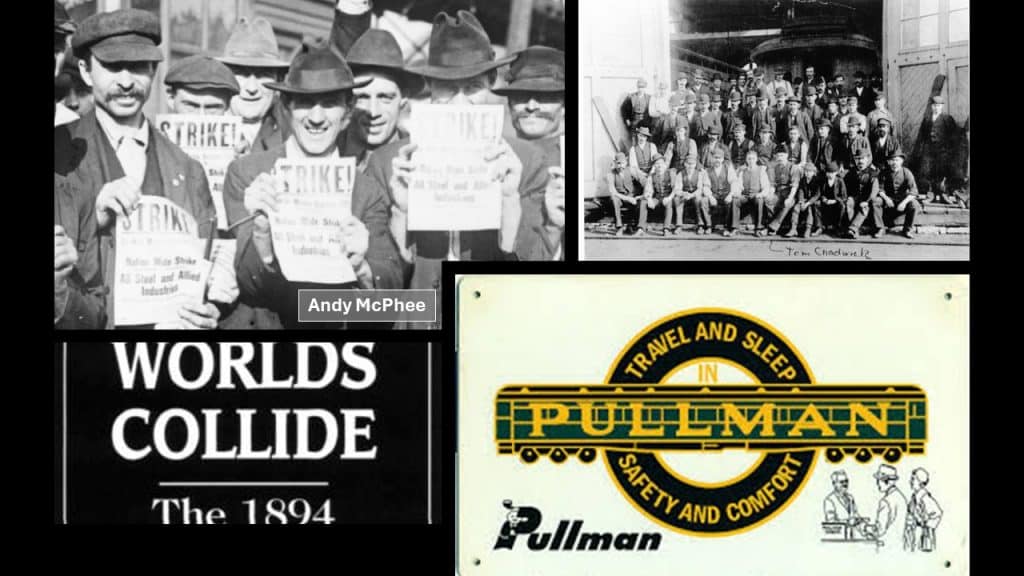
At the end of June 1894 attitudes escalated. Fires had been set to buildings and a train, hitched to a mail car, had been derailed. These acts brought forth the federal government’s attention. The rail companies requested assistance from the Feds to help end the strike.
National Guard Called
In the beginning of July the National Guard was called into Chicago to enforce the injunction. Striking workers rallied and destroyed “hundreds of railcars” on July 6th. The National Guardsmen fired into a crowd of people, killing 30, with many more being wounded.
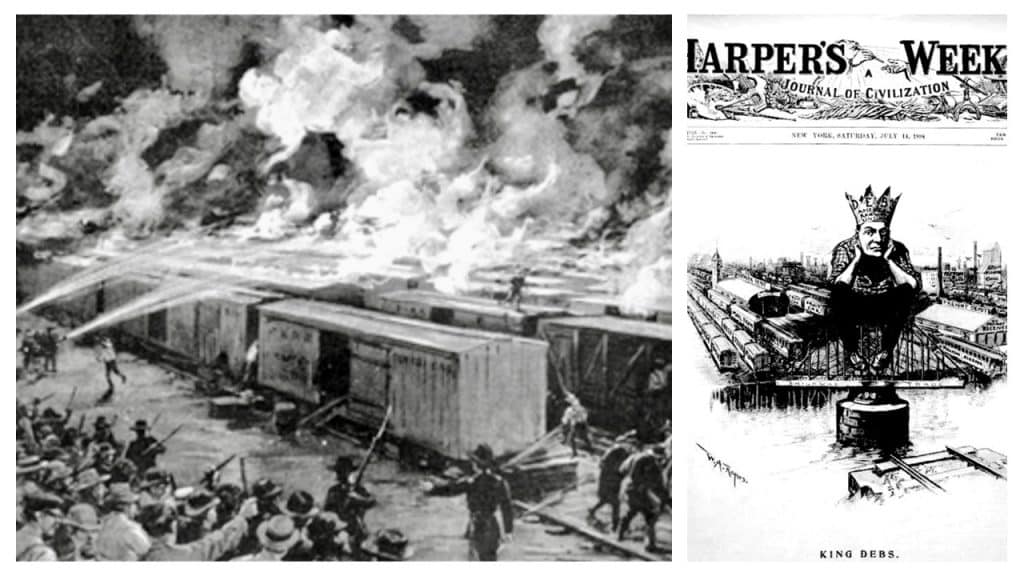
The Strike Ends
After the National Guard’s show of force, the strike ended on July 20, 1894.
Congress Acts
As violence in Chicago raged, Congress passed a bill proposing that Labor Day be a national holiday.
The idea of paying homage to workers had come from New York’s Central Labor Union’s annual celebrations, beginning just two years earlier. ‘Let’s celebrate our workers across the nation.’ had been an attempt to recognize the working class, but by this point it had been a small bandage over a gaping wound. Yet, this would at least be a tiny step toward easing tensions. The bill was sent to the President.
Labor Day Becomes A National Holiday
As President Grover Cleveland reviewed this bill on his desk, he faced this challenge with astute direction. Something positive had to be done. President Grover Cleveland signed this bill into law. Labor Day would be celebrated on the first Monday in September.
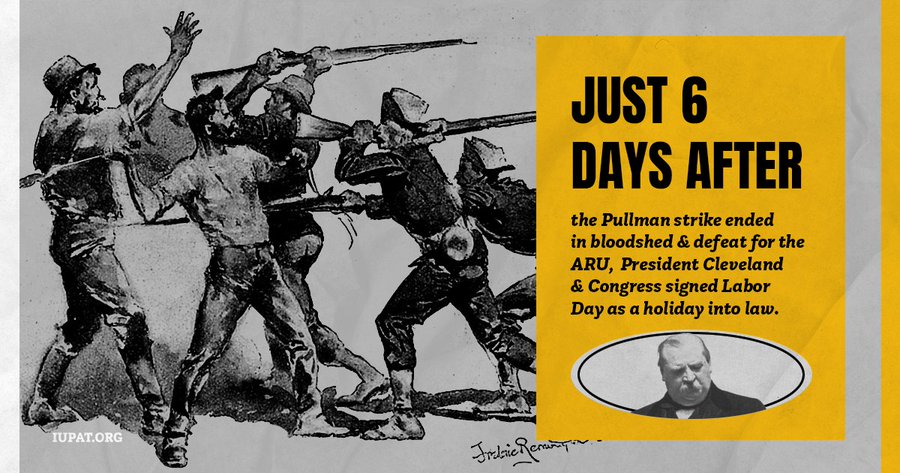
“Just 6 days after the pullman strike ended in bloodshed & defeat for the ARU, President Cleveland & Congress signed ‘Labor Day’ as a holiday into law.”
Commission Investigation Appointed by President

Photo Credit: The New York Times
President Grover Cleveland appointed a commission to investigate the strike. The government acknowledged the vital importance of negotiations which must be available between employers and employees. The commission also found George Pullman partially to blame for the strike.
Robert Todd Lincoln – Company President 1897
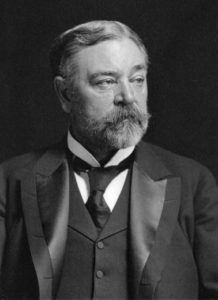
Three years later, upon George Pullman’s death in 1897, Robert Todd Lincoln, Abraham Lincoln’s second oldest, stepped into the position of the Pullman Company’s President. Robert Todd Lincoln slowly led the Pullman Company in a new direction with the insistence of the Illinois Supreme Court.
Illinois Supreme Court Ruling
The Presidential Commission findings had provided precedence to the Illinois Supreme Court. In 1898 their ruling “ordered Pullman (Company) to sell all non-industrial land holdings in the town, but the company did not comply until 1907.”
“The Brotherhood” – A. Philip Randolph
With the solidarity formed by the Pullman workers, “The Brotherhood of Sleeping Car Porters” organized a union in 1925. This African American organization had been a driving force in the future Civil Rights movement.
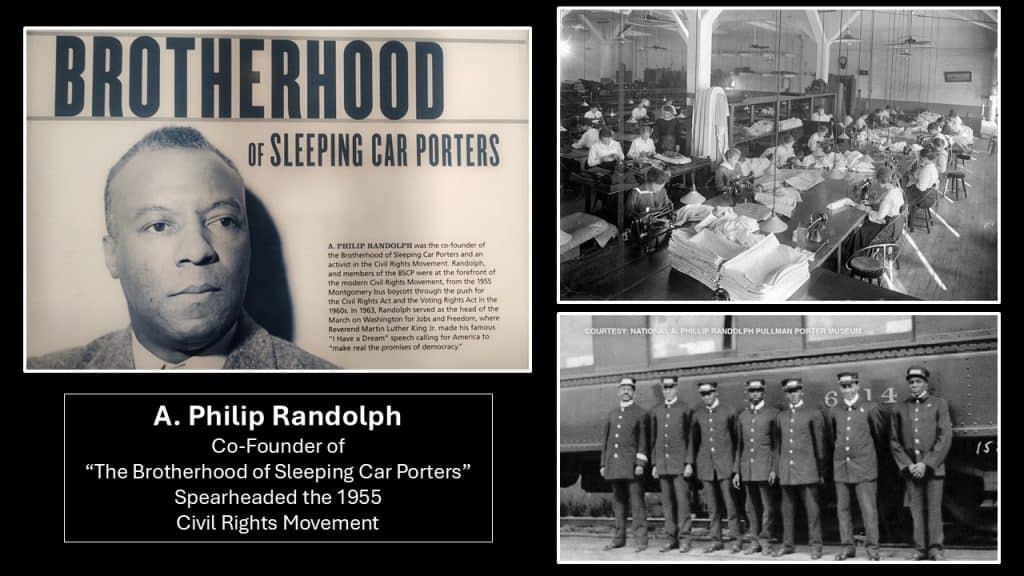
Asa Philip Randolph had led the Civil Rights Movement in the 1950’s, “Freedom is never granted: It is won. Justice is never given: It is exacted,”
Pullman National Park
By the 1960’s the use of trains had fallen with the rise in family automobiles and delivery trucks. Plans were drawn out to flatten the Pullman buildings and construct an industrial park.
The community banded together to save these original buildings, forming the “Pullman Civic Organization.” By 1969 the Town of Pullman had been designated as a Historic District and soon after named one of the first ‘Landmark Districts’ of Chicago.

Today, the Pullman neighborhood is a thriving community.
In 1991 the Hotel Florence, the Pullman Factory Clock Tower and the Administration buildings became property of the Illinois Historic Preservation Agency. Extensive restoration work has been done. Since 1993, people can visit this property, a National Park.
Labor Day Reflection
As a teacher, I gladly paid my dues to be part of our union. Having the right to bargain contracts, lobby lawmakers for kids and the backing of a lawyer, if needed, brought a professional sense of security. Especially after hearing stories of my father’s early teaching career, I have appreciated the union.
Being surrounded by the Pullman National Park and the A. Philip Randolph Museum has brought a clearer appreciation and admiration for the Pullman workers’ astute bravery. As well, I hadn’t been aware of ‘The Brotherhood,’ Pullman porters and maids, and their vital role they had played in the Civil Rights Movement. I am looking forward to going back to the Pullman National Park, retracing the foundation they laid for us today. What a legacy!
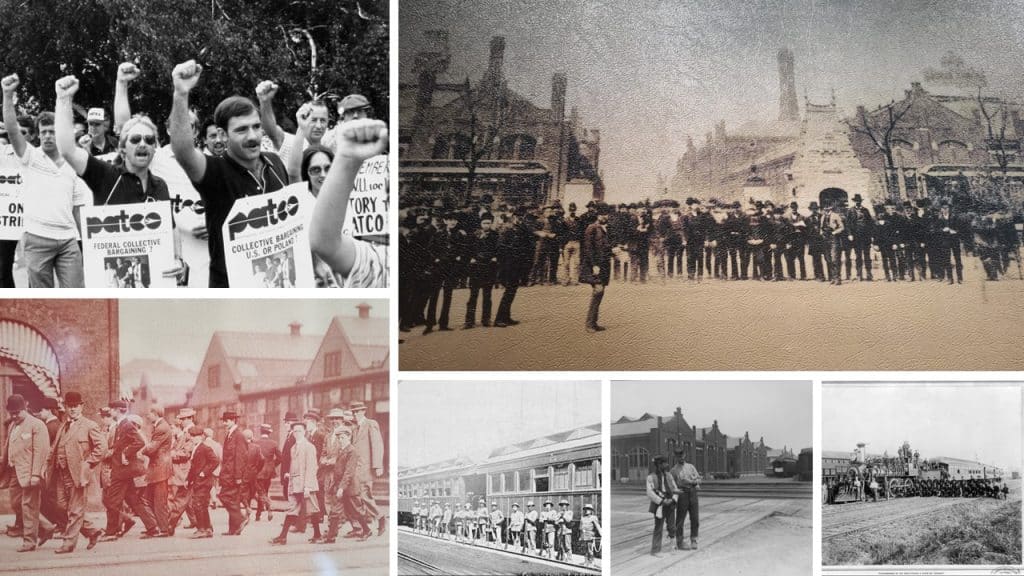
“Labor Day should be a moment when we all reflect the critical contributions of working people to the political, economic and cultural development of this country,” Claudrena Harold, a history professor at the University of Virginia, stated to an National Public Radio journalist, Jaclyn Diaz.
Resources:
Pullman Website
WTTW PBS Station article
The Daily JSTOR “Pullman Women at Work” article
Click On Detroit article
University of Chicago article
Reddit article
IUPAT post
Brainy Quotes website
NPR article September 2022
Windy City Historians podcast
The History Reader by Philip Jett “Robert Todd Lincoln: Blessed and Cursed” article





